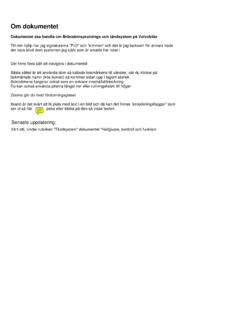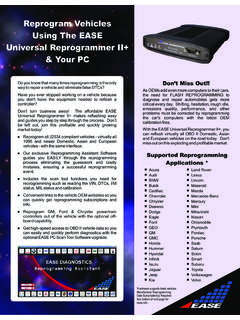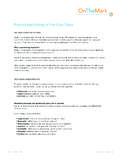Transcription of Service Manual - 240
1 , ..,.. 0,0 Service Manual Fault tracing .. Section 3 (32) Charging system 240, 260 1975-19 TP 30729/ 1 Printed in . We reserve the right to make alterations el 1984, volvo OF AMERICA CORPORATION Charging System Fault Tracing 240/260; 1975 - 19 .. Contents Operation Test equipment and system description Test equipment .. Suggested equipment .. The charging system, brief description .. Fault tracing Fautt tracing .. The don'ts of fault tracing .. Ouick check .. A . Mandatory troubleshooting pre-checks .. Al -A4 Battery testing .. B. Battery testing procedures.
2 Bl -B6 Fautt tracing chart .. Fault t r acing procedures, charging C1 -C12 Alternator scope patterns .. System specifications and battery charging Wiring diagrams .. Alternator specifications .. Transi stor voltage regulator, specifications .. Charging a battery .. Diode kit .. Order number: TP 30729-1 We reserve the right to make alterations without prior notilication. Page 2 4 5 8 8 10 11 12 14 16 17 24 25 33 36 37 37 Group 32 Fault tracing Test equipment ." . I #~~ ,~ -A~P ~ES .'00 @ e @ ----.. L ' 0 '2 . kf' ~~, . , . VOLTS @;" :!.---e " Test equipment @~ IJAr~ Ep 9 9'Ep-( ~ Marquette 42 130 volts ampere tester, Sun Vat 40 volts ampere tester (or equivalent) The unit contains a voltmeter, ammeter, built~in carbon pile resistor, and a diade/stator tester.)
3 When using this equipment or similar equipment. foHow the manufacturer's instructions. Digital multi meter ( volvo 9996525 3, Fluke 80228 or equivalent) Used to measure current, voltage and resistance. Remember: To take resistance rea dings properly, the circuit being tested must be electrically disconnected from adjacent circuits and voltage should not be present. 133 427 ,* '" ". ,. 6 ~7~ , AMP ., .. , .. , * ., . wo l' l, ~ .. " III .11 "' , " ." ., ." ., ., ., ., , , . , , , ." . " ." ." ." ." ." ." ., ." Group 32 Fault tracing Test equipment Test light Used to check for current drain or to check for voltage present in a circuit.
4 Test light glows when approximately 150 milliamperes flow through the light (the amount of current needed to illuminate the test light varies between test lights; 150 milli-amper es is approximate.) Hydrometer with thermometer ( volvo 998-5011-7. Snap-On BB4A or equivalent) The hydrometer is used la measure the specific grav ity of the e lectrolyte in battery cells. This measurement gives an indication of the battery s state of charge . low-amperage charger (Marquette Model 30-, 36. Schumaker 43141 or equivalent) Recharges 6 and 12 volt batteries in 3 to 7 hours.
5 Slow charge of 6 amps prevents battery damage caused by overheating. 3 Group 32 Fault tracing Test equipment Suggested equipment This equipment is strong ly recommended. DO ~I L-I ---' GGG QQQQ Q o 4 Oscilloscope (automotive) Gives a visual indieation of the alternator output. Can be used to quiekly analyze alternator faults. Refer to manufaeturer's instruetions provided w ith the unit. (Examples of normal and abnormal seope patterns are included in Specifieations Seetion.) c 133 322 Group 32 Fault tracing Components Charging system. brief description Alternator with integral regulator L8gend: A _"'""".
6 Ier 8 19<I/IIofI .. C AIUof1>Io'Of IIS~_Of Regulator NOTE Drawing to the left is only representative of charging systems in general. Refer to speci-fications for specific wiring diagrams. The charging system consists of three components, the alternator, battery, and voltage regulator. Al Alternator Converts the rotary motion of the engine into an electrical current. There are two general types of alternators used on Volvos. One type uses an externa I regulator and the other an integral (built-inl regulator. Shown is a representative drawing of an alternator with integral regulator.)
7 Bl Battery Stores an electrical charge for starting the ear. The battery also helps smooth out voltage fluctuations. There are three types of batteries. standard. low maintenance. and maintenance free. 5 Group 32 Fault tracing Components 127522 6 Standard battery Water needs to be added periodically. Mayemit significant amounts of gas. Low-maintenance ( volvo presently equips cars with low-maintenance batteries on ly) Never needs water added undernormal condi-tions. Check level at normal services or at least once a year. Reduced gassing. Low self-discharge. Maintenance free ( volvo does not presently use maintenance-free batteriesj -No vent plugs.)
8 -Water cannot be added. -Very little gassing. SEV externa I regulator Bosch externai regulator 134543 Integral regulator 1352ee Integral regulator Group 32 Fautt tracing Components el Volta ge regulators Externai transistor regulator Regulates by solid-state electronics. No moving parts. Relivable, can withstand vibration. Can be mounted on the alternator as an integral regulator. Integral regulator -Transistor-type regulator mounted on the alternator. -Compact. NQT E The regulated voltage varies with the tempera-ture of the regulator. As the temperature of the regulator increases, the regulated voltage decreases.
9 On same 1985 and later modeis, the regulator is connected to a temperature sensor located beneath the battery tray; thus, the regu-lated voltage is more precisely matched to the system's immediate requirements. 7 Group 32 Fault tracing Don'ts of fault tracing General Fault tracing This section explains the fault tracing method ofcorrecting charging system defects. All fault tracing must be done in the sequence presented in this section. "Short-cut" methods undermine the efficiency of the fault tracing method. FIAST Tro~bleshooting Pre-checks .. ' then Battery Testing the n Charging System Fault Tracing The don'ts of fault tracing When testing or servicing an alternator, avoid damaging the unit and its regulator by carefully observing the following precautions: 8 Al Never disconnect battery cables or the wires to the regulator cables while the engine is running.
10 Bl Never reverse battery connections. Check the bauery pola rit y with a voltmeter before making connections if the polarity signs "+" or "o" are not visible on the battery case. f i FIELD \IJII.,?!> ID+/61:~ , l' Group 32 Fault rracing Don'ts of !ault tracing C) Disconnect the battery cables before hooking up a fast charger. Never use a fast charger as a booster for starting the ear. Do not charge battery with bat-tery installed in ear; gassing can damage the paint. D) Avoid grounding the field circuit (0+/61) between the alternatar and the regulator. Groundi ng the field of either alternator or regu-lator may damage the regulator.






